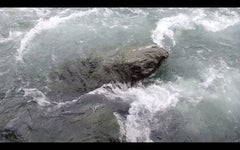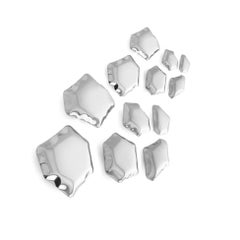ODETTA More Art
to
2
2
2
Overall Height
to
Overall Width
to
2
2
2
1
1
1
2
Artist: Fritz Horstman
Fritz Horstman, Kannagawa Voices, 2015, Video
By Fritz Horstman
Located in Darien, CT
While working on a large building project several years ago the artist, Fritz Horstman was struck by the poetry in the unfinished state of the construction site. He was drawn specifically to the space between the plywood walls that were raised as formworks for the pouring of cement. That space could only exist for a few hours before the cement truck...
Category
2010s Conceptual More Art
Materials
Video
Fritz Horstman, Ice Voices, 2016, Video
By Fritz Horstman
Located in Darien, CT
While working on a large building project several years ago the artist, Fritz Horstman was struck by the poetry in the unfinished state of the construction site. He was drawn specifi...
Category
2010s New Media More Art
Materials
Video
Related Items
Kamyki 12, Wall Mounted Sculptures in Stainless Steel by Oskar Zieta
Located in Paris, FR
Kamyki original decorative wall mirror (12 pieces), Zieta
DImensions: Ø 7-20 cm
Material: stainless steel.
Dimensions of the set :
H. 86 cm
W. 102 cm
D. 6 cm
About the Zieta collec...
Category
21st Century and Contemporary Contemporary Sculptures
Materials
Stainless Steel
H 33.86 in W 40.16 in D 2.37 in
The Chameleon Effect - Flexible Rigids - sculptural wall, parametric design
By Hugo Garcia-Urrutia
Located in Dallas, TX
HUGO G. URRUTIA
B. 1974, Mexico
Hugo G. Urrutia is a multidisciplinary artist-designer, interested in the cross-pollination between art and architecture. His artwork challenges the...
Category
2010s New Media Abstract Sculptures
Materials
Plywood, Lacquer, Oil
Kamyki 6 Emerald, Mounted Sculpture by Oskar Zieta
Located in Paris, FR
Kamyki original decorative wall mirror (6 pieces), Zieta
DImensions: Ø 7-20 cm
Material: stainless steel.
Color: Emerald
Dimensions of the set :
H. 40 cm
W. 61 cm
D. 6 cm
About the...
Category
21st Century and Contemporary Contemporary Sculptures
Materials
Stainless Steel
H 2.37 in W 24.02 in D 15.75 in
Ouroboros
By General Idea
Located in Toronto, Ontario
In 1967, General Idea was founded in Toronto by AA Bronson (b. 1946), Felix Partz (1945-1994), and Jorge Zontal (1944-1994). Over the course of 25 years, they made a significant contribution to postmodern and conceptual art in Canada and beyond.
General Idea was both prolific and multi-disciplinary long before it became de rigueur. Together, they worked across photography, sculpture, painting, mail art, video, installation, multiples, and performance. The group also made a significant number of unconventional editioned works and was inspired by the idea of the anti-art object.
Thematic continuity was a key element in General Idea's work. Early on they introduced talismans or logos that they would revisit and re-envision, including skulls, ziggurats, and poodles.
They were particularly interested in (European) crests used for centuries to represent a city, district, or even a creative or professional guild. General Idea both appropriated and reinterpreted existing crests (often by replacing a lion with a poodle) as well as creating crests that were entirely of their own imagination.
Between 1988 and 1989, General Idea created 8 chenille crests with some of their most iconic motifs. These crests recalled their traditional European antecedents and the aesthetics of high-school sports teams and varsity jackets.
"Ouroboros" features General Idea's most famous mascot, the poodle, who mimics the lion's pose often seen in traditional European iconography. Entangled in the twists and curls of its tail, the poodle appears to be consuming the tip of it, embodying the full 'ouroboros' or circle of life.
Completed in a menacing palette of black, forest green, and electric red, this design is a classic General Idea; subversive, zany, and mischievous.
While these crests were intended to be an unlimited edition, according to the General Idea Editions catalog raisonné, less than 100...
Category
1980s Conceptual More Art
Materials
Textile
Kamyki 12 Emerald, Mounted Sculpture by Oskar Zieta
Located in Paris, FR
Kamyki original decorative wall mirror (12 pieces), Zieta
DImensions: Ø 7-20 cm
Color: Emerald
About the Gradient collection:
The Gradient collection combines an exceptional depth a...
Category
21st Century and Contemporary Contemporary Sculptures
Materials
Stainless Steel
H 33.86 in W 40.16 in D 2.37 in
Kamyki, Mounted Sculpture in Stainless Steel by Oskar Zieta
Located in Paris, FR
Kamyki original decorative wall mirror (6 pieces), Zieta
DImensions: Ø 7-20 cm
Material: stainless steel.
Dimensions of the set :
H. 40 cm
W. 61 cm
D. 6 c...
Category
21st Century and Contemporary Contemporary Sculptures
Materials
Stainless Steel
H 2.37 in W 24.02 in D 15.75 in
Sea Plane : Long Lake
By Gerard Giliberti
Located in East Hampton, NY
Sea Plane at Long Lake
Black & White photography
Archival Pigment Print
Created 2011
Edition: 1 of 5
Made to Order
21" x 14 (Print can be printed larger.)
...
Category
2010s New Media Black and White Photography
Materials
Archival Pigment
Laundromat- video wall sculpture inspired by film noir by the McGuire studio
By Davy and Kristin McGuire
Located in New York, NY
The McGuires have created a body of work inspired by the seedy, shady underworld of Film Noir. Inhabited by gritty gangsters and femme fatales these characters come alive within a se...
Category
21st Century and Contemporary Contemporary More Art
Materials
Video, Mixed Media
H 12.6 in W 9.8 in D 9.8 in
Two Screenprinted pillow cases (one hand signed by Baldessari) in bespoke box
By John Baldessari
Located in New York, NY
John Baldessari Pillow Cases in Bespoke Presentation Box (one pillowcase hand signed by John Baldessari) for The Thing Quarterly Issue 22, 2014
Silkscreen on 100% cotton 320 thread count sateen pillowcases (Hand signed by John Baldessari)
Boldly signed in ink by John Baldessari on one of the pillowcases (see photo)
Unframed
One of the pillowcases is hand signed in ink by John Baldessari:
John Baldessari was one of the artists who were invited to contribute an object (or "thing") with text for a special project for "The Thing" publication (read on for more on "The Thing") ; the conceptual object therefore had to incorporate text. Baldessari's contribution in 2014 was a silkscreened pillowcase with text. A limited (unknown) number of these pillowcases were marketed and sold as a set of two in a bespoke box. However, exceptionally, Baldessari hand signed a very few of pillowcases in ink. This is one of the very special sets bearing one hand signed pillow case - purchased directly from "The Thing". (a copy of the 2014 receipt is shown here.) The rest of these boxed sets were not hand signed.
The pillowcase is brand new, and will look gorgeous once pressed and framed by a professional framer.
More about this boxed set:
Issue 22 of THE THING Quarterly is by LA-based conceptual artist John Baldessari. It consists of two 100% cotton sateen pillowcases featuring an image of a woman clutching a pillow. The black and white image is taken from a Hollywood film still in Baldessari's collection and has been silkscreened on each pillowcase with environmentally-friendly, water-based ink. The pillowcases are standard-sized and envelope-style. For those who like their thread count high, the issue clocks in at a solid 320 thread count.
Measurements:
Box
10.5 inches by 13 inches by 2 inches
Pillow
20 inches vertical by 26 inches
What was The Thing Quarterly?
THE THING was an experimental publication created in collaboration with Will Rogan as part of an artist residency. We saw it as a quarterly periodical in the form of an object. Each year, four artists, writers, musicians or filmmakers were invited to create an everyday object that somehow incorporates text. The object is reproduced and hand wrapped at wrapping parties and then mailed to the homes of the subscribers with the help of the United States Postal Service.
It began as part of an artist residency in San Francisco’s Southern Exposure. Will and I had met in grad school at UC Berkeley and discovered our mutual affinity for quarterlies. He was a librarian at SFAI for five years and I had been a high school teacher for five years. WE were both interested pushing the boundaries of publication. Our plan was to create a 1 year publication with four artists, but from the very start the project generated so much interest and international excitement that we found ourselves running a publication complete with a brick and mortar storefront and a staff of four individuals. After 10 years, 34 issues, 59 projects and countless live events, we decided to end the publication in order to pursue our individual projects. We are still working together on a less ambitious new project, and hope to launch it at some point in 2021.
CONTRIBUTORS: have included John Baldessari, Dave Eggers, Miranda July...
Category
2010s Conceptual More Art
Materials
Ink, Mixed Media, Cardboard, Fabric, Cotton, Screen
Ja Ja Ja Ja Nee Nee Nee, 1969, Sound Art, Conceptual Art, Disco
By Joseph Beuys
Located in Milano, IT
Una performance di Joseph Beuys, registrata alla Staatliche Kunstakademie di Düsseldorf nel 1968.
Interpreti: J. Beuys in collaborazione con H. Christiansen e J. Stüttgen.
Questa è...
Category
1960s Conceptual More Art
Materials
Cardboard
H 13.78 in W 13.78 in D 0.4 in
Untitled hourglass drawing
By Marina Abramovic
Located in New York, NY
Marina Abramović
Untitled hourglass drawing, 1992
Drawing done in black marker, hand signed and annotated and held inside the softback catalogue for the artist's 1992 Beaux Arts exhi...
Category
1990s Conceptual Abstract Drawings and Watercolors
Materials
Mixed Media, Permanent Marker
When Fur Flies
By General Idea
Located in Toronto, Ontario
In 1967, General Idea was founded in Toronto by AA Bronson (b. 1946), Felix Partz (1945-1994), and Jorge Zontal (1944-1994). Over the course of 25 years, they made a significant contribution to postmodern and conceptual art in Canada and beyond.
General Idea was both prolific and multi-disciplinary long before it became de rigueur. Together, they worked across photography, sculpture, painting, mail art, video, installation, multiples, and performance. The group also made a significant number of unconventional editioned works and were inspired by the idea of the anti-art object.
Thematic continuity was a key element in General Idea's work. Early on they introduced talismans or logos that they would revisit and re-envision, including skulls, ziggurats, and poodles.
They were particularly interested in (European) crests used for centuries to represent a city, district, or even a creative or professional guild. General Idea both appropriated and reinterpreted existing crests (often by replacing a lion with a poodle) as well as creating crests that were entirely of their own imagination.
Between 1988 and 1989, General Idea created 8 chenille crests with some of their most iconic motifs. These crests recalled their traditional European antecedents and the aesthetics of high-school sports teams and varsity jackets.
"When the Fur Flies" is the most colorful and curious example from the series. A pink poodle, which appears almost as a curly abstraction, mimics the lion's pose often seen in traditional European iconography. Behind the famous General Idea mascot are stylized three yellow mushroom clouds. This design is a classic General Idea; subversive, zany, queer, and mischievous.
While these crests were intended to be an unlimited edition, according to the General Idea Editions catalog raisonné, less than 100...
Category
1980s Conceptual More Art
Materials
Textile



